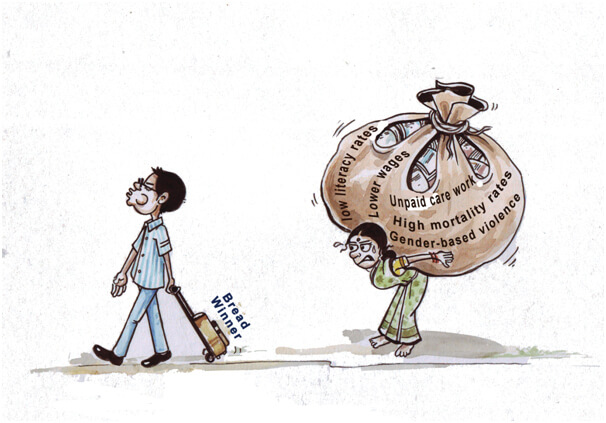Gender Budgeting

Gender Budgeting has become a powerful tool for gender mainstreaming. Over the past two decades, women’s empowerment has been increasingly recognized as a crucial factor for any country’s holistic and sustainable development. Several programs and projects across the world have been launched and are currently in progress to bring social, economic and political equity and broader access to basic livelihood needs.
India formally adopted gender budgeting in 2005. In that year, finance minister P. Chidambaram included in the budget documents a separate statement on spending programmes that benefit women in particular. It was his predecessor Yashwant Sinha who began the preparatory work for a shift to gender budgeting.
Why focussing on gender?
- Women represent 48% of total population in country.
- Women face disparities in access to and control over services and resources.
- There are specific needs of women that need to be addressed (practical and strategic gender needs).
- Bulk of Public Expenditure and policy concerns are in Gender Neutral Sectors.
- Implications on women in the above sectors are not recognised or identified (gender blind).
What is Gender Budgeting?
It is an attempt to scrutinize the budget from the gender lens and bring out the gender differential impact. In Gender Budgeting, “Gender” means women and her empowerment.
Gender budgeting is used as a tool for effective policy implementation where one can check if the allocations are in line with policy commitments and are having the desired impact.
Gender budget is not:
- A separate budget.
- About spending the same on women and men.
- Just about assessing programmes targeted specifically at women and girls.
- Confined to budgets alone. It covers analyzing various economic policies from the gender perspective.
Why gender budget?
The achievement of human development is highly dependent on the development and empowerment of the 496 million women and girls. In addition, the Constitution of India has mandated equality for every citizen of the country as a fundamental right.
Nevertheless, the reality is that women in India continue to face disparities in access to and control over resources. These disparities are reflected in indicators of health, nutrition, literacy, educational attainments, skill levels, occupational status among others.
The poor status and value attached to women is also reflected in the fact that the female sex ratio for the 0-6 age group declined from an already low 945 in 1991 to 927 in 2001, implying that millions of girls went missing in just a decade. There are a number of gender-specific barriers which prevent women and girls from gaining access to their rightful share.
Unless these barriers are addressed in the planning and development process, the fruits of economic growth are likely to completely bypass a significant section of the country’s population. This, in turn, does not augur well for the future growth of the economy.
Issues to be addressed:
Total magnitude of Gender Budget is very low.
Focus has been mainly on identifying programmes/schemes meant entirely for women or having visible components that benefit women.
Very little information is available in the public domain as regards the assumptions made by various ministries in the reviews of their expenditure profiles from a gender perspective.
Many misleading and patriarchal assumptions limit the scope of Gender Budgeting.
Sectors such as Water Supply, Sanitation, and Food & Public Distribution still remain outside the purview of the GB Statement.
Large schemes do not figure yet in the Gender Budgeting Statement.
What needs to be done to make gender budgeting more effective?
Gender budgeting should be fully incorporated into standard budget processes so that it becomes fully institutionalized. Otherwise, even initiatives adopted with enthusiasm may not be sustained. Some elements of gender budgeting, such as an analysis of benefits or tax incidence, may require periodic special efforts.
It should address specific goals, such as reducing inequality in educational attainment, that have clear benefits and can be measured even with somewhat crude tools and data.
It should draw on civil society for support and assistance with the more research-oriented aspects, and should apply to subnational levels of government where relevant. It should cover both spending and revenue.
It should not be a rule set specific goals for spending on women-related objectives because this tends to reduce flexibility, making the budget process less effective.
What more is needed?
Interventions like gender budgeting are undoubtedly welcome. However, gender budgeting alone is unlikely to solve the massive problem of gender inequality that not only prevents women from living a full life but also hurts economic growth.
For example, India has the lowest level of female participation in the labour force when compared to most other regional economies. Indian women enter the labour force only when there is economic distress while they retreat back into their homes once the situation improves—a rare case of employment going down when the economy improves.
Another issue that needs public policy attention is public goods. These by their very nature are accessible for all citizens because their consumption is neither exclusive nor rival. Yet, the lack of certain core public goods such as safe streets or lack of clean drinking water are more likely to hurt the economic prospects of women more than men.
The argument for safe streets is almost self-evident. The lack of clean drinking water on tap in effect means that women in many parts of the country spend several hours every day walking in search of water.
To sum up:
Reducing gender disparities can lead to improved macroeconomic performance. The recognition that gender disparities are harmful and that government budgets are not gender neutral implies a need to incorporate gender considerations into the budgeting process. Although gender-budgeting initiatives can take many different forms, their most important purpose is to influence the budgeting process and help policymakers focus on ways that public policies can help reduce gender disparities and improve economic outcomes. India is still a laggard when it comes to gender equality, and changing this situation is an urgent task


